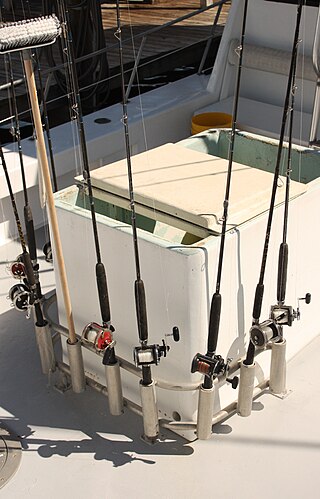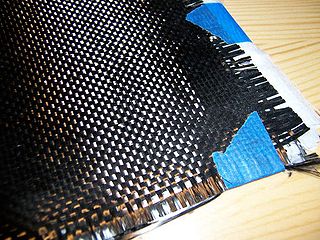
A fishing rod or fishing pole is a long, thin rod used by anglers to catch fish by manipulating a line ending in a hook. At its most basic form, a fishing rod is a straight rigid stick/pole with a line fastened to one end ; however, modern rods are usually more elastic and generally have the line stored in a reel mounted at the rod handle, which is hand-cranked and controls the line retrieval, as well as numerous line-restricting rings that distribute bending stress along the rod and help dampening down/prevent line whipping and entanglement. To better entice fish, baits or lures are dressed onto the hook attached to the line, and a bite indicator is typically used, some of which might be incorporated as part of the rod itself.

A fishing reel is a hand-cranked reel used in angling to wind and stow fishing line, typically mounted onto a fishing rod, but may also be used on compound bows or crossbows to retrieve tethered arrows when bowfishing.

Carbon fibers or carbon fibres are fibers about 5 to 10 micrometers (0.00020–0.00039 in) in diameter and composed mostly of carbon atoms. Carbon fibers have several advantages: high stiffness, high tensile strength, high strength to weight ratio, high chemical resistance, high-temperature tolerance, and low thermal expansion. These properties have made carbon fiber very popular in aerospace, civil engineering, military, motorsports, and other competition sports. However, they are relatively expensive compared to similar fibers, such as glass fiber, basalt fibers, or plastic fibers.
Fiberglass or fibreglass is a common type of fiber-reinforced plastic using glass fiber. The fibers may be randomly arranged, flattened into a sheet called a chopped strand mat, or woven into glass cloth. The plastic matrix may be a thermoset polymer matrix—most often based on thermosetting polymers such as epoxy, polyester resin, or vinyl ester resin—or a thermoplastic.

Fly fishing is an angling technique that uses an ultra-lightweight lure called an artificial fly, which typically mimics small invertebrates such as flying and aquatic insects to attract and catch fish. Because the mass of the fly lure is insufficient to overcome air resistance, it cannot be launched far using conventional gears and techniques, so specialized tackles are used instead and the casting techniques are significantly different from other forms of angling. It is also very common for the angler to wear waders, carry a hand net, and stand in the water when fishing.
A cermet is a composite material composed of ceramic and metal materials.
Orvis is an American family-owned retail and mail-order business specializing in fly fishing, hunting and sporting goods. Founded in Manchester, Vermont, in 1856 by Charles F. Orvis to sell fishing tackle, it is the oldest mail-order retailer in the United States.
Filament winding is a fabrication technique mainly used for manufacturing open (cylinders) or closed end structures. This process involves winding filaments under tension over a rotating mandrel. The mandrel rotates around the spindle while a delivery eye on a carriage traverses horizontally in line with the axis of the rotating mandrel, laying down fibers in the desired pattern or angle to the rotational axis. The most common filaments are glass or carbon and are impregnated with resin by passing through a bath as they are wound onto the mandrel. Once the mandrel is completely covered to the desired thickness, the resin is cured. Depending on the resin system and its cure characteristics, often the mandrel is autoclaved or heated in an oven or rotated under radiant heaters until the part is cured. Once the resin has cured, the mandrel is removed or extracted, leaving the hollow final product. For some products such as gas bottles, the 'mandrel' is a permanent part of the finished product forming a liner to prevent gas leakage or as a barrier to protect the composite from the fluid to be stored.
ABU Garcia, originally AB Urfabriken, then ABU Svängsta, is a fishing reel and equipment manufacturing company founded in Svängsta, Sweden, and is now owned by Pure Fishing conglomerate of the United States.

Fishing tackle is the equipment used by anglers when fishing. Almost any equipment or gear used in fishing can be called fishing tackle, examples being hooks, lines, baits/lures, rods, reels, floats, sinkers/feeders, nets, spears, gaffs and traps, as well as wires, snaps, beads, spoons, blades, spinners, clevises and tools that make it easy to tie knots.
Fly rod building is the art of constructing a fly fishing rod to match the performance desires of the individual angler. Fly rods are usually made of graphite or cane poles. There are several commercial manufacturers of fly rods, including Echo, Hardy, Zephrus, G. Loomis, Orvis, Reddington, Sage, Scott, St. Croix, Temple Fork Outfitters, and R. L. Winston; however, many individuals make fly rods for personal pleasure or profit.

A bamboo fly rod or a split cane rod is a fly fishing rod that is made from bamboo. The British generally use the term "split cane." In the U.S., most use the term "bamboo." The "heyday" of bamboo fly rod production and use was an approximately 75-year period from the 1870s to the 1950s when fiberglass became the predominant material for fly rods. Nevertheless, bamboo fly rods made from skilled makers continue to be 'state-of-the-art' in performance and are cherished and revered by their owners.

A bass boat is a small boat that is designed and equipped primarily for bass fishing, usually in freshwater bodies such as lakes, rivers and wetlands. The modern bass boats are motorboats that feature an elevated flat front deck with swivel chairs that permit the angler to readily cast to any direction around the boat, large storage containers for fishing tackles and equipment such as rods, reels and lures, high-performance fishfinders, and a recirculating livewell where caught fish may be stored and kept alive for prolonged periods of time.
The Shakespeare Company is a subsidiary of Pure Fishing which manufactures fishing equipment. It was founded by William Shakespeare Jr. in Kalamazoo, Michigan in 1897. It was moved to Columbia, South Carolina in 1970.
Fly fishing tackle comprises the fishing tackle or equipment typically used by fly anglers. Fly fishing tackle includes:
Carbon fiber-reinforced polymers, carbon-fibre-reinforced polymers, carbon-fiber-reinforced plastics, carbon-fiber reinforced-thermoplastic, also known as carbon fiber, carbon composite, or just carbon, are extremely strong and light fiber-reinforced plastics that contain carbon fibers. CFRPs can be expensive to produce, but are commonly used wherever high strength-to-weight ratio and stiffness (rigidity) are required, such as aerospace, superstructures of ships, automotive, civil engineering, sports equipment, and an increasing number of consumer and technical applications.
William Shakespeare Jr. was an American inventor.
Penn Fishing Tackle Manufacturing Company is an American manufacturer of fishing tackle, primarily known for making heavy-duty fishing reels and rods.
Curran is a microcrystalline nanocellulose fibre derived from the pulp of root vegetables. It was developed by Scottish scientists David Hepworth and Eric Whale, with funding from the Scottish Government. The sources of root vegetable pulp used to manufacture Curran include carrots, sugar beets, and turnips. It is named after curran, the Scottish Gaelic word for "carrot". The material was developed as a potential substitute for carbon fibre and is often used in polymer composites. It has numerous industrial and technological applications, especially for the production of paints and sporting equipment.
Fenwick is a brand name of Pure Fishing.






